Jonathan R. McHargue – Served on Both Sides
Posted By Norman Gasbarro on November 26, 2012
In Pleasant Hill Baptist Cemetery, Wilkes County, North Carolina, there lies buried a Union Army veteran of the Civil War, Jonathan R. McHargue, whose grave marker clearly indicates his service in the 50th Pennsylvania Infantry, Company C. In researching this soldier, it was quickly discovered that he was a North Carolinian by birth who first served in a Confederate regiment, then was captured, was given amnesty, and proceeded to join the 50th Pennsylvania Infantry, Company C – a company and regiment composed heavily of Schuylkill County, Pennsylvania, men. Jonathan R. McHargue served the Union honorably from 20 March 1864 through 30 July 1865. As the available records show, he returned home to North Carolina after the war and applied for an pension which he received based on his service in the 50th Pennsylvania Infantry – and after his death, his widow received until her death.
How this all came about is still being researched, but an interesting story is emerging. The text of an obituary dated 23 November 1921, Greensboro Daily News [North Carolina], posted on-line in an Ancestry.com tree relates some of the story:
J. R. McHargue passes away at his home in West Elkin, [North Carolina], 23 November 1921 – Early Sunday morning at this home in West Elkin, J. R. McHargue passed away after a protracted illness of many months. He was 76 years of age, a consecrated Christian and a consistent member of the Baptist church. He is survived by his wife, three daughters and one son. The funeral was conducted from the home by Rev. W.T. Baucom, interment following in the cemetery at Pleasant Hill Church. 24 November 1921 He enlisted into the Confederacy on 6 October 1863 at Camp Vance, North Carolina. He was in the 4th North Carolina Infantry Regiment. Two months later, on 5 December 1863 Jonathan was captured by Union soldiers in Culpeper, Virginia and taken to Capitol Prison in Washington, DC. Upon taking an oath of amnesty he was released and taken to Philadelphia. He then joined the 50th Pennsylvania Infantry, a Union regiment. He stayed with the unit and applied for and received a pension from the Federal Government for his service. His Pennsylvania unit information is carved onto his tombstone in Surry County, North Carolina.
The Pension Index Card for Jonathan R. McHargue does not state the location from which he applied for a pension in 1885 – but does note that his widow applied from North Carolina in 1922. In both cases the “certificate numbers” given are proof that the pension was received. Pension Index Cards, available through Ancestry.com, reference application files available in the National Archives in Washington, D.C.
From the data base found on Ancestry.com, U.S. Civil War Soldier Records and Profiles, some basic information is found about McHargue’s Confederate enlistment:
The source given in the above data record is North Carolina Troops, 1861-1865, A Roster. While the muster date of 6 October 1863 noted, and the place of residency as Watauga County, North Carolina, there is no discharge date or capture date. If the information in the obituary is correct, then the capture took place on 5 December 1863. The hyperlink in the record, Company B, North Carolina 4th Infantry Regiment, leads to a history of this Confederate regiment and lists the battles and skirmishes in which the regiment participated:
From the above sequence, it probably can be assumed that Jonathan R. McHargue joined his regiment after it had fought on 24 July 1863 at Manassas, Virginia. He then took part in battles or skirmishes at Warrenton and Bristoe Station, Virginia, on 14 October 1863; Charles City Court House, Virginia, 1 November 1863: Washington, North Carolina, 6 November 1863; Kelly’s Ford, Virginia, 8 November 1863; Payne’s Farm, Virginia, on 28 November 1863; and Mine Run, Virginia, 30 November 1863; before participating at Culpepper, Virginia, where he was captured on 5 December 1863, a date after the Union Army records indicate the skirmish took place.
An earlier battle at Culpepper Court House, Virginia, 13 September 1863, is not included in the list of 4th North Carolina Infantry battles and skirmishes. The Battle of Culpepper Court House took place before Jonathan R. McHargue joined his regiment. It was a cavalry engagement and 100 Confederates were taken prisoner. The 4th North Carolina Infantry, although in the vicinity in September, did not take part in the that battle. Continued fighting in the area eventually resulted in the skirmish at Culpepper in December 1863 at which place McHargue was captured.
The story then shifts to Washington, D.C.. As a prisoner of war, and perhaps either wounded or in recovery from some disease, Jonathan R. McHargue was transported there – to the Capitol Prison, which was located behind the Capitol building. This building served as a temporary capitol from 1815 to 1819, but was converted to a prison during the Civil War. In 1929, it was razed and the present Supreme Court building was erected there. Upon taking an oath of allegiance to the Union, Jonathan R. McHargue was transported north to Philadelphia.
Philadelphia was the site of the Great Central Fair (at Logan Square) which was sponsored by the United States Sanitary Commission. The following description is from the web site of the Library Company of Philadelphia:
In 1861, the Philadelphia branch of the relief organization, the United States Sanitary Commission, began collecting monetary donations in order to supply Union soldiers with basic necessities and medical supplies. Although the Philadelphia branch raised $135,000 in the span of 2 years, the war effort demanded more supplies and support. The success of Sanitary Fairs in Chicago, Cincinnati and Boston encouraged the Philadelphia agency to experiment with its own Fair in June 1864. Local businesses and institutions donated their products and services to support the patriotic cause and exhibited a wide array of valuable goods and curiosities under one roof. Although the Sanitary Commission asked all members of society to support their countrymen, the spectacle was limited to those who could afford the admission prices.
At Philadelphia, Jonathan R. McHargue was given the opportunity to assist in the Union war effort by enrolling in a Pennsylvania regiment – which he did by enrolling in the 50th Pennsylvania Infantry. The Great Central Fair, noted above, was not yet constructed when he arrived in the city, but the services of the United States Sanitary Commission were available as well as many military recruiters who were seeking able-bodied men for the war effort.
As the above card shows, the 18 year-old Jonathan R. McHargue enrolled in the 50th Pennsylvania Infantry on 20 March 1864 at Reading, Berks County,Pennsylvania. He gave his occupation as farmer as his residence as Berks County – although it was unlikely that he had “lived” there very long. His arrival in Reading from Philadelphia was probably by train – about a 90 minute ride. His physical description 6’1″ tall, dark hair, gray eyes, and florid complexion is recorded on the Veterans’ Index Card which references Bates’ History (Volume 1, page 1292).
After joining the 50th Pennsylvania Infantry, he participated in engagements at the Wilderness, Virginia, beginning 6 May 1864; Spotsylvania Court House, beginning 9 May 1864; Cold Harbor, beginning 1 June 1864; Petersburg, beginning 17 June 1864; the Weldon Railroad, beginning 19 August 1864; and finally, Petersburg, his regiment ending their fighting there on 2 April 1865. What is interesting about this list of battles is that Jonathan R. McHargue‘s old regiment – the 4th North Carolina Infantry – participated in most of these, but on the other side. It is not known whether he encountered any of his former comrades during this time.
On 30 July 1865, Jonathan R. McHargue was honorably discharged from the 50th Pennsylvania Infantry at Georgetown, Washington, D.C. Where he immediately went at the end of the war is not known. But before the year 1865 ends, he does appear in another enlistment record – that of the Regular Army:
On 9 November 1865, Jonathan R. McHargue, 22 years old of North Carolina, enrolled in the 8th U.S. Infantry, Company G, for a term of 3 years.
Was this the same person who served in the 4th North Carolina Infantry and the 50th Pennsylvania Infantry? The physical description of gray eyes and dark hair as well as the 6 foot height are a close match!
But, for some unknown reason, Jonathan R. McHargue did not serve his full enlistment in the Regular Army and was reported as “Deserted” (“Des’d”) on 18 August 1866.
Although he has not yet been located in the 1870 Census, a later census states that around 1868, he married Elizabeth W. Williams. Censuses since 1880 place him and his family in North Carolina, and as previously stated, he applied for a pension in 1885, based on his service in the 50th Pennsylvania Infantry – and without apparent mention of his Confederate service (which wouldn’t have qualified him for a U.S. pension), or his brief stint in the Regular Army (which recorded him as a deserter).
An 1890 Veterans’ Census for Jonathan R. McHargue has not been located. Perhaps he was reluctant to admit that he had served in a Union regiment during the Civil War. In 1910, he did admit service. The initials “U.A.” appear on the census line with his name (below):
Not much is known about the life of Jonathan R. McHargue beyond his military service. The names of his children, all born in North Carolina, appear in census returns – and his death certificate is available on-line through Ancestry.com. As previously mentioned, pension application files are available at the National Archives in Washington, D.C. and can be obtained using the application numbers on the Pension Index Card.
The Civil War Research Project welcomes additional information on this soldier who served on both sides of the war. Comments can be added to this post or can be sent by e-mail to the Project.
——————————
Pictures of the Capitol Prison and the Great Central Fair are from Wikipedia. The grave marker picture at the top of this post is from a public tree on Ancestry.com and originally from Findagrave.
 ;
;

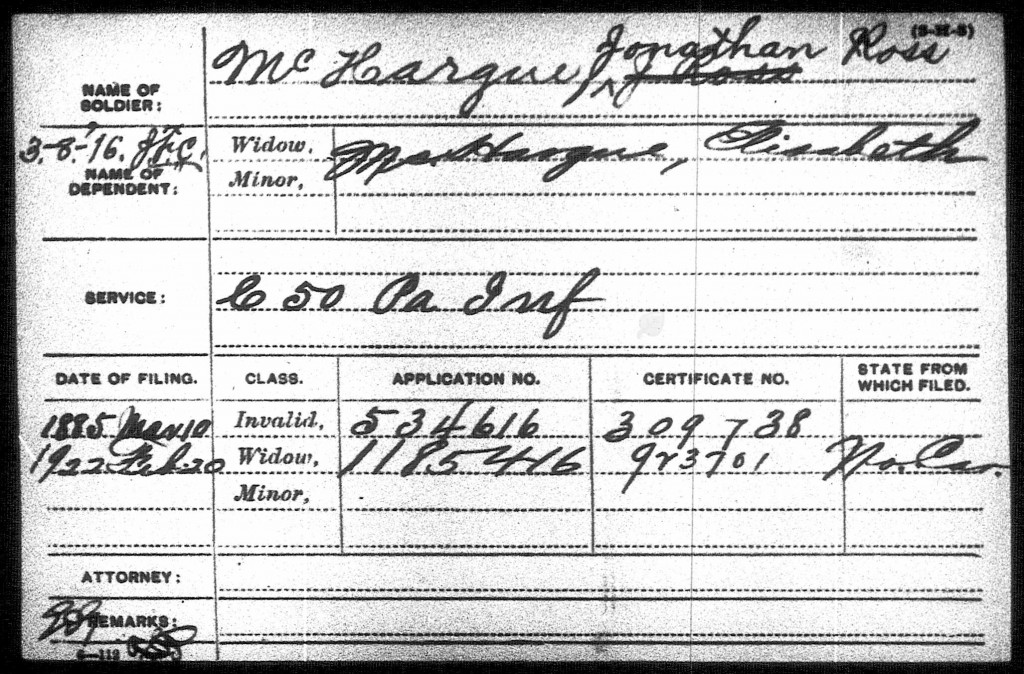
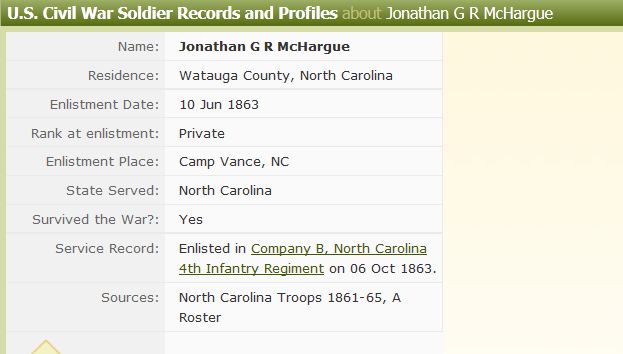
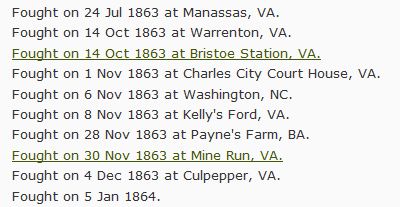
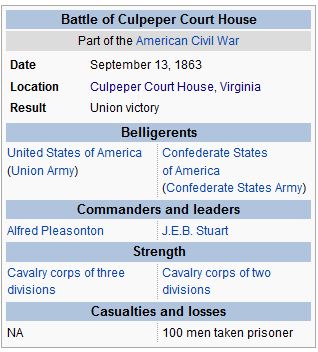
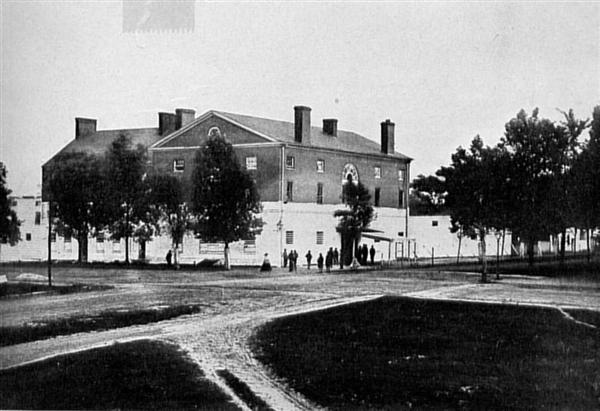
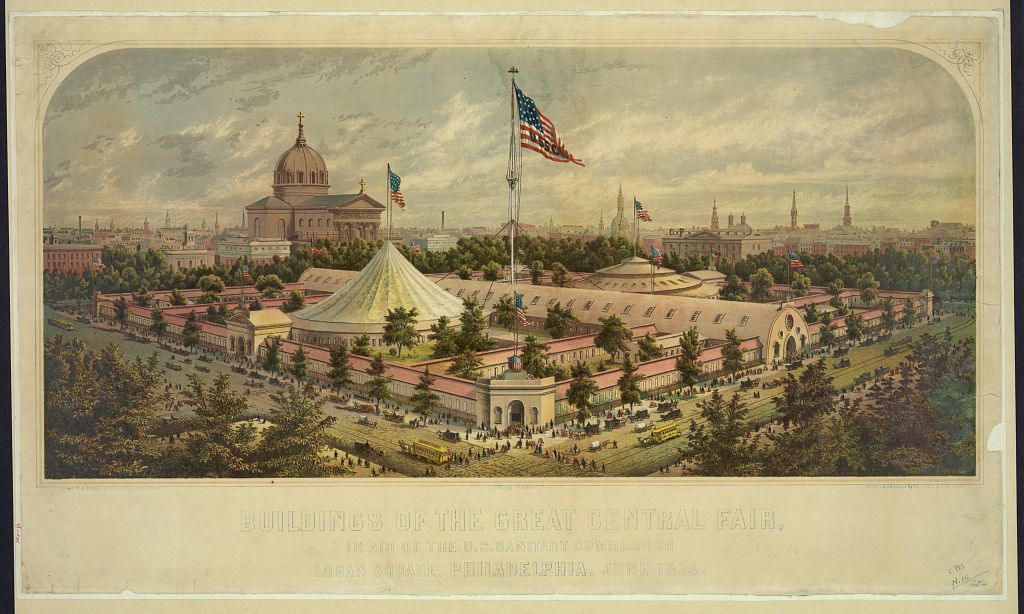
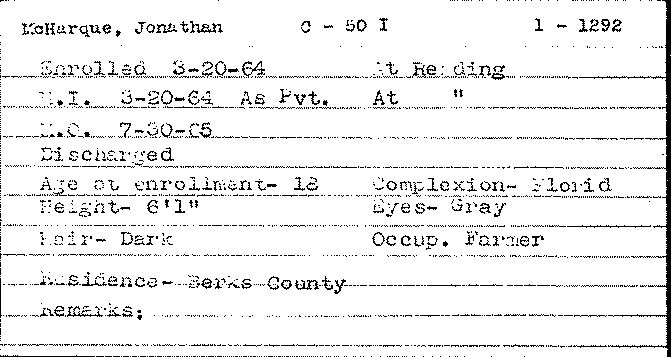
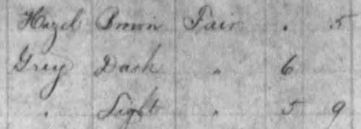




Comments